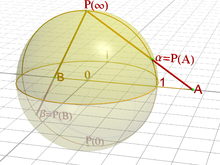Fractals/moebius

Möbius transformation is an example of plane transformation
definition
[edit | edit source]A Möbius transformation [1][2][3][4] of extended complex plane is a rational function f of the form
of one complex variable z.
Here the coefficients a, b, c, d and the result w are complex numbers satisfying
Representation or form
[edit | edit source]- function
- matrix
Function
[edit | edit source]
Matrix
[edit | edit source]In matrix form by using homogeneous coordinates:[5]
Matrix M is a square 2x2 invertible matrix[6]
Examples
[edit | edit source]- Transforms using Complex Numbers
- Moebius transformation in mandelbrot-graphics library
- Mathematics of Kleinian Group Fractals by hiddendimension
- Generalized circles and Möbius transformations by Stéphane Laurent
- Projective Transformation and Mobius Transformation by Tadao Ito
simple
[edit | edit source]The following simple transformations are also Möbius transformations:
- is an identity
- is a translation
- is a combination of a homothety and a rotation.
- If then it is a rotation
- if then it is a homothety
- inversion and reflection with respect to the real axis)
How to ...?
[edit | edit source]eigenvalue and eigenvector
[edit | edit source]A number and a non-zero vector satisfying
are called an eigenvalue and an eigenvector of matrix M, respectively.
For dimensions 2 formulas involving radicals exist that can be used to find the eigenvalues. The eigenvalues can be found by using the quadratic formula:
diagonalization
[edit | edit source]a diagonal matrix is a matrix in which the entries outside the main diagonal are all zero. In other words all off-diagonal elements are zero in a diagonal matrix.
the main diagonal of a matrix is the list of entries where , here
the diagonalization of a matrix M gives a pair of matrices: D, P such that:[8]
- D is diagonal (all elements not on the diagonal are 0)
For 2x2 matrices there is a simple closed form solution[9]
Product with a scalar
[edit | edit source]If A is a matrix and c a scalar, then the matrices and are obtained by left or right multiplying all entries of A by c.
trace
[edit | edit source]The trace of a square 2x2 matrix
is the sum of its diagonal entries
So
determinant
[edit | edit source]determinant of matrix
inverse
[edit | edit source]
Inverse Möbius transformation[10]
.
interpolation
[edit | edit source]How to smootly interpolate between möbius transformations?[11][12]
If you have two Möbius transformations represented as:
where coefficients are complex numbers
Is it possible to derive a third function , where and , which "smoothly" interpolates between the transformations represented by and ?
The solution:
Specifying a transformation by three points
[edit | edit source]Given a set of three distinct points z1, z2, z3 on the one Riemann sphere ( let's call it z-sphere) and a second set of distinct points w1, w2, w3 on the second sphere ( w-sphere) , there exists precisely one Möbius transformation f(z) with :
for i=1,2,3
Mapping to 0, 1, infinity
[edit | edit source]The Möbius transformation with an explicit formula :[13]
maps :
- z1 to w1= 0
- z2 to w2= 1
- z3 to w3= ∞
the unit circle to the real axis - first method
[edit | edit source]Let's choose 3 z points on a circle :
- z1= -1
- z2= i
- z3= 1
then the Möbius transformation will be :
Knowing that :[14]
one can simplify this to :
In Maxima CAS one can do it :
(%i1) rectform((z+1)*(%i-1)/((z-1)*(%i+1))); (%o1) (%i*(z+1))/(z−1)
where coefficients of the general form are :
so inverse function can be computed using general form :
Lets check it using Maxima CAS :
(%i3) fi(w):=(-%i-w)/(%i-w); (%o3) fi(w):=−%i−w/%i−w (%i4) fi(0); (%o4) −1 (%i5) fi(1); (%o5) −%i−1/%i−1 (%i6) rectform(%); (%o6) %i
Find how to compute it without symbolic computation program (CAS) :
(%i3) fi(w):=(-%i-w)/(%i-w); (%o3) fi(w):=−%i−w/%i−w (%i8) z:x+y*%i; (%o8) %i*y+x (%i9) z1:fi(w); (%o9) (−%i*y−x−%i)/(−%i*y−x+%i) (%i10) realpart(z1); (%o10) ((−y−1)*(1−y))/((1−y)^2+x^2)+x^2/((1−y)^2+x^2) (%i11) imagpart(z1); (%o11) (x*(1−y))/((1−y)^2+x^2)−(x*(−y−1))/((1−y)^2+x^2) (%i13) ratsimp(realpart(z1)); (%o13) (y^2+x^2−1)/(y^2−2*y+x^2+1) (%i14) ratsimp(imagpart(z1)); (%o14) (2*x)/(y^2−2*y+x^2+1)


So using notation :
one gets :
It can be used for unrolling the Mandelbrot set components [15]
the unit circle to the real axis - second method
[edit | edit source]Function :
sends the unit circle to the real axis :
- z=1 to w=0
- z=i to w=1
- z=-1 to
Mapping to the imaginary axis
[edit | edit source]Function sends the unit circle to the imaginary axis.[16]
visualisations
[edit | edit source]- mobius revealed by Mark McClure
- live demo by Tim Hutton
- Iterating the Möbius transformation by Tim Hutton
References
[edit | edit source]- ↑ Möbius transformation in wikipedia
- ↑ Moebius transformation animated GIFs by Fritz Mueller
- ↑ Möbius Transforms App by (c) Robert Woodley, 2016-2017.
- ↑ Transformations of the projective line
- ↑ oeis.org : Moebius transformation
- ↑ Matrix in wikipedia
- ↑ Squares that Look Round: Transforming Spherical Images by Saul Schleimer and Henry Segerman
- ↑ How to diagonalize a matrix ? in wikipedia
- ↑ interpolating moebius transformations
- ↑ inverse of a matrix by Bruce Simmons
- ↑ mathoverflow question: ow-to-smootly-interpolate-between-moebius-transformations
- ↑ interpolating moebius transformations by Claude Heiland-Allen
- ↑ Triple transitivity by David J Wright 2004-12-04
- ↑ math.stackexchange questions : how-to-do-this-transformation-of-complex-rational-function
- ↑ Stretching cusps by Claude Heiland-Allen
- ↑ math.stackexchange questions: what-mobius-transformation-maps-the-unit-circle-z-z-1-to-the-real-axis/335061#335061




























































